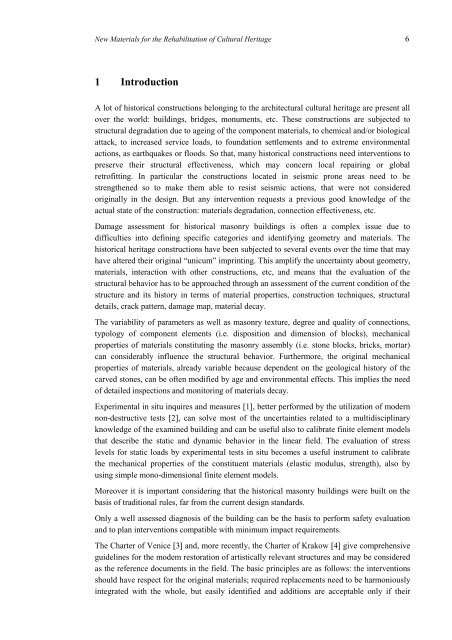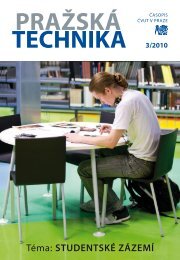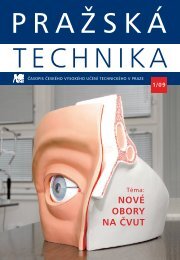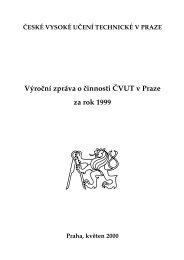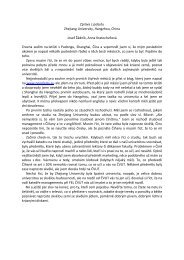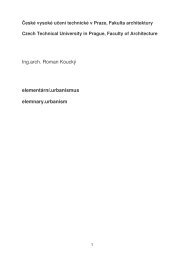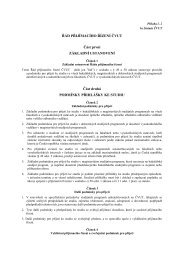New Materials for the Rehabilitation of Cultural Heritage - Czech ...
New Materials for the Rehabilitation of Cultural Heritage - Czech ...
New Materials for the Rehabilitation of Cultural Heritage - Czech ...
You also want an ePaper? Increase the reach of your titles
YUMPU automatically turns print PDFs into web optimized ePapers that Google loves.
<strong>New</strong> <strong>Materials</strong> <strong>for</strong> <strong>the</strong> <strong>Rehabilitation</strong> <strong>of</strong> <strong>Cultural</strong> <strong>Heritage</strong> 6<br />
1 Introduction<br />
A lot <strong>of</strong> historical constructions belonging to <strong>the</strong> architectural cultural heritage are present all<br />
over <strong>the</strong> world: buildings, bridges, monuments, etc. These constructions are subjected to<br />
structural degradation due to ageing <strong>of</strong> <strong>the</strong> component materials, to chemical and/or biological<br />
attack, to increased service loads, to foundation settlements and to extreme environmental<br />
actions, as earthquakes or floods. So that, many historical constructions need interventions to<br />
preserve <strong>the</strong>ir structural effectiveness, which may concern local repairing or global<br />
retr<strong>of</strong>itting. In particular <strong>the</strong> constructions located in seismic prone areas need to be<br />
streng<strong>the</strong>ned so to make <strong>the</strong>m able to resist seismic actions, that were not considered<br />
originally in <strong>the</strong> design. But any intervention requests a previous good knowledge <strong>of</strong> <strong>the</strong><br />
actual state <strong>of</strong> <strong>the</strong> construction: materials degradation, connection effectiveness, etc.<br />
Damage assessment <strong>for</strong> historical masonry buildings is <strong>of</strong>ten a complex issue due to<br />
difficulties into defining specific categories and identifying geometry and materials. The<br />
historical heritage constructions have been subjected to several events over <strong>the</strong> time that may<br />
have altered <strong>the</strong>ir original “unicum” imprinting. This amplify <strong>the</strong> uncertainty about geometry,<br />
materials, interaction with o<strong>the</strong>r constructions, etc, and means that <strong>the</strong> evaluation <strong>of</strong> <strong>the</strong><br />
structural behavior has to be approached through an assessment <strong>of</strong> <strong>the</strong> current condition <strong>of</strong> <strong>the</strong><br />
structure and its history in terms <strong>of</strong> material properties, construction techniques, structural<br />
details, crack pattern, damage map, material decay.<br />
The variability <strong>of</strong> parameters as well as masonry texture, degree and quality <strong>of</strong> connections,<br />
typology <strong>of</strong> component elements (i.e. disposition and dimension <strong>of</strong> blocks), mechanical<br />
properties <strong>of</strong> materials constituting <strong>the</strong> masonry assembly (i.e. stone blocks, bricks, mortar)<br />
can considerably influence <strong>the</strong> structural behavior. Fur<strong>the</strong>rmore, <strong>the</strong> original mechanical<br />
properties <strong>of</strong> materials, already variable because dependent on <strong>the</strong> geological history <strong>of</strong> <strong>the</strong><br />
carved stones, can be <strong>of</strong>ten modified by age and environmental effects. This implies <strong>the</strong> need<br />
<strong>of</strong> detailed inspections and monitoring <strong>of</strong> materials decay.<br />
Experimental in situ inquires and measures [1], better per<strong>for</strong>med by <strong>the</strong> utilization <strong>of</strong> modern<br />
non-destructive tests [2], can solve most <strong>of</strong> <strong>the</strong> uncertainties related to a multidisciplinary<br />
knowledge <strong>of</strong> <strong>the</strong> examined building and can be useful also to calibrate finite element models<br />
that describe <strong>the</strong> static and dynamic behavior in <strong>the</strong> linear field. The evaluation <strong>of</strong> stress<br />
levels <strong>for</strong> static loads by experimental tests in situ becomes a useful instrument to calibrate<br />
<strong>the</strong> mechanical properties <strong>of</strong> <strong>the</strong> constituent materials (elastic modulus, strength), also by<br />
using simple mono-dimensional finite element models.<br />
Moreover it is important considering that <strong>the</strong> historical masonry buildings were built on <strong>the</strong><br />
basis <strong>of</strong> traditional rules, far from <strong>the</strong> current design standards.<br />
Only a well assessed diagnosis <strong>of</strong> <strong>the</strong> building can be <strong>the</strong> basis to per<strong>for</strong>m safety evaluation<br />
and to plan interventions compatible with minimum impact requirements.<br />
The Charter <strong>of</strong> Venice [3] and, more recently, <strong>the</strong> Charter <strong>of</strong> Krakow [4] give comprehensive<br />
guidelines <strong>for</strong> <strong>the</strong> modem restoration <strong>of</strong> artistically relevant structures and may be considered<br />
as <strong>the</strong> reference documents in <strong>the</strong> field. The basic principles are as follows: <strong>the</strong> interventions<br />
should have respect <strong>for</strong> <strong>the</strong> original materials; required replacements need to be harmoniously<br />
integrated with <strong>the</strong> whole, but easily identified and additions are acceptable only if <strong>the</strong>ir


